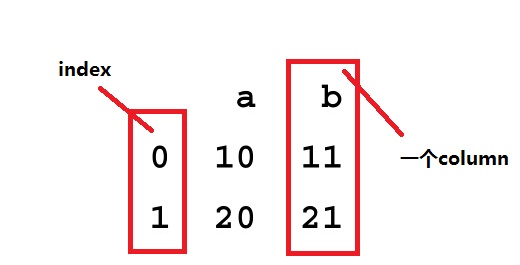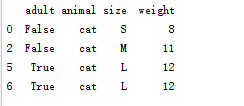继上一篇文章,这篇文章介绍一下Pandas模块里面的DataFrame结构
1. 介绍
DataFrame unifies two or more Series into a single data structure.Each Series then represents a named column of the DataFrame, and instead of each column having its own index, the DataFrame provides a single index and the data in all columns is aligned to the master index of the DataFrame.
这段话的意思是,DataFrame提供的是一个类似表的结构,由多个Series组成,而Series在DataFrame中叫columns(理解有错请指出,(逃~
2. 相关操作
a.create
pd.DataFrame()
参数:
1、二维array;
2、Series 列表;
3、value为Series的字典;
a.1、二维array
import pandas as pd
import numpy as np
s1=np.array([1,2,3,4])
s2=np.array([5,6,7,8])
df=pd.DataFrame([s1,s2])
print df
- 1
- 2
- 3
- 4
- 5
- 6
- 7
a.2、Series列表(效果与二维array相同)
import pandas as pd
import numpy as np
s1=pd.Series(np.array([1,2,3,4]))
s2=pd.Series(np.array([5,6,7,8]))
df=pd.DataFrame([s1,s2])
print df
- 1
- 2
- 3
- 4
- 5
- 6
- 7
a.3、value为Series的字典结构;
import pandas as pd
import numpy as np
s1=pd.Series(np.array([1,2,3,4]))
s2=pd.Series(np.array([5,6,7,8]))
df=pd.DataFrame({"a":s1,"b":s2});
print df
- 1
- 2
- 3
- 4
- 5
- 6
- 7

注:若创建使用的参数中,array、Series长度不一样时,对应index的value值若不存在则为NaN
b.属性
b.1 .columns :每个columns对应的keys
b.2 .shape:形状,(a,b),index长度为a,columns数为b
b.3 .index;.values:返回index列表;返回value二维array
b.4 .head();.tail();
c.if-then 操作
c.1使用.ix[]
df=pd.DataFrame({"A":[1,2,3,4],"B":[5,6,7,8],"C":[1,1,1,1]})
df.ix[df.A>1,'B']= -1
print df
- 1
- 2
- 3
df.ix[条件,then操作区域]
c.2使用numpy.where
df=pd.DataFrame({"A":[1,2,3,4],"B":[5,6,7,8],"C":[1,1,1,1]})
df["then"]=np.where(df.A<3,1,0)
print df
- 1
- 2
- 3

np.where(条件,then,else)
d.根据条件选择取DataFrame
d.1 直接取值df.[]
df=pd.DataFrame({"A":[1,2,3,4],"B":[5,6,7,8],"C":[1,1,1,1]})
df=df[df.A>=2]
print df
- 1
- 2
- 3
d.2 使用.loc[]
df=pd.DataFrame({"A":[1,2,3,4],"B":[5,6,7,8],"C":[1,1,1,1]})
df=df.loc[df.A>2]
print df
- 1
- 2
- 3
(还有很多种方法就不一一列举了)
e.Grouping
e.1groupby 形成group
df = pd.DataFrame({'animal': 'cat dog cat fish dog cat cat'.split(),
'size': list('SSMMMLL'),
'weight': [8, 10, 11, 1, 20, 12, 12],
'adult' : [False] * 5 + [True] * 2});
#列出动物中weight最大的对应size
group=df.groupby("animal").apply(lambda subf: subf['size'][subf['weight'].idxmax()])
print group
- 1
- 2
- 3
- 4
- 5
- 6
- 7

e.2 使用get_group 取出其中一分组
df = pd.DataFrame({'animal': 'cat dog cat fish dog cat cat'.split(),
'size': list('SSMMMLL'),
'weight': [8, 10, 11, 1, 20, 12, 12],
'adult' : [False] * 5 + [True] * 2});
group=df.groupby("animal")
cat=group.get_group("cat")
print cat
- 1
- 2
- 3
- 4
- 5
- 6
- 7
- 8
其他具体操作请参考CookBook
http://pandas.pydata.org/pandas-docs/stable/cookbook.html
<原创文章,转载请注明出处>
<link rel="stylesheet" href="https://csdnimg.cn/release/phoenix/production/markdown_views-68a8aad09e.css">
</div>
继上一篇文章,这篇文章介绍一下Pandas模块里面的DataFrame结构
1. 介绍
DataFrame unifies two or more Series into a single data structure.Each Series then represents a named column of the DataFrame, and instead of each column having its own index, the DataFrame provides a single index and the data in all columns is aligned to the master index of the DataFrame.
这段话的意思是,DataFrame提供的是一个类似表的结构,由多个Series组成,而Series在DataFrame中叫columns(理解有错请指出,(逃~
2. 相关操作
a.create
pd.DataFrame()
参数:
1、二维array;
2、Series 列表;
3、value为Series的字典;
a.1、二维array
import pandas as pd
import numpy as np
s1=np.array([1,2,3,4])
s2=np.array([5,6,7,8])
df=pd.DataFrame([s1,s2])
print df
- 1
- 2
- 3
- 4
- 5
- 6
- 7
a.2、Series列表(效果与二维array相同)
import pandas as pd
import numpy as np
s1=pd.Series(np.array([1,2,3,4]))
s2=pd.Series(np.array([5,6,7,8]))
df=pd.DataFrame([s1,s2])
print df
- 1
- 2
- 3
- 4
- 5
- 6
- 7
a.3、value为Series的字典结构;
import pandas as pd
import numpy as np
s1=pd.Series(np.array([1,2,3,4]))
s2=pd.Series(np.array([5,6,7,8]))
df=pd.DataFrame({"a":s1,"b":s2});
print df
- 1
- 2
- 3
- 4
- 5
- 6
- 7

注:若创建使用的参数中,array、Series长度不一样时,对应index的value值若不存在则为NaN
b.属性
b.1 .columns :每个columns对应的keys
b.2 .shape:形状,(a,b),index长度为a,columns数为b
b.3 .index;.values:返回index列表;返回value二维array
b.4 .head();.tail();
c.if-then 操作
c.1使用.ix[]
df=pd.DataFrame({"A":[1,2,3,4],"B":[5,6,7,8],"C":[1,1,1,1]})
df.ix[df.A>1,'B']= -1
print df
- 1
- 2
- 3
df.ix[条件,then操作区域]
c.2使用numpy.where
df=pd.DataFrame({"A":[1,2,3,4],"B":[5,6,7,8],"C":[1,1,1,1]})
df["then"]=np.where(df.A<3,1,0)
print df
- 1
- 2
- 3

np.where(条件,then,else)
d.根据条件选择取DataFrame
d.1 直接取值df.[]
df=pd.DataFrame({"A":[1,2,3,4],"B":[5,6,7,8],"C":[1,1,1,1]})
df=df[df.A>=2]
print df
- 1
- 2
- 3
d.2 使用.loc[]
df=pd.DataFrame({"A":[1,2,3,4],"B":[5,6,7,8],"C":[1,1,1,1]})
df=df.loc[df.A>2]
print df
- 1
- 2
- 3
(还有很多种方法就不一一列举了)
e.Grouping
e.1groupby 形成group
df = pd.DataFrame({'animal': 'cat dog cat fish dog cat cat'.split(),
'size': list('SSMMMLL'),
'weight': [8, 10, 11, 1, 20, 12, 12],
'adult' : [False] * 5 + [True] * 2});
#列出动物中weight最大的对应size
group=df.groupby("animal").apply(lambda subf: subf['size'][subf['weight'].idxmax()])
print group
- 1
- 2
- 3
- 4
- 5
- 6
- 7

e.2 使用get_group 取出其中一分组
df = pd.DataFrame({'animal': 'cat dog cat fish dog cat cat'.split(),
'size': list('SSMMMLL'),
'weight': [8, 10, 11, 1, 20, 12, 12],
'adult' : [False] * 5 + [True] * 2});
group=df.groupby("animal")
cat=group.get_group("cat")
print cat
- 1
- 2
- 3
- 4
- 5
- 6
- 7
- 8
其他具体操作请参考CookBook
http://pandas.pydata.org/pandas-docs/stable/cookbook.html
<原创文章,转载请注明出处>
<link rel="stylesheet" href="https://csdnimg.cn/release/phoenix/production/markdown_views-68a8aad09e.css">
</div>





